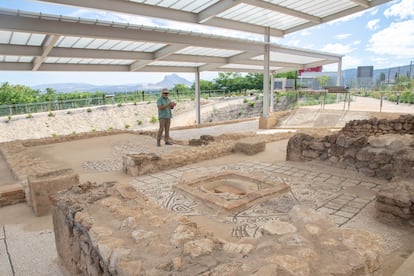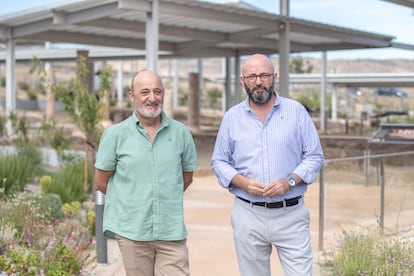Antequera opens to the public the Roman villa with the largest geometric mosaic on the Iberian Peninsula

Licinia Logas was one of the most powerful women of Roman Antikaria. She died at the age of 35 and was buried very close to the spectacular villa owned by her family, the Licinians. Like her, for generations they dedicated themselves to the production of olive oil in the lands of Roman Baetica, transforming themselves into something similar to the current business giant Dcoop , also from Antequera, but in a family version. They displayed their power in a house that was pure luxury to impress visitors and that, 16 centuries later, continues to amaze, now an archaeological site. Only a quarter of its 23,000 square meters of unique terraced architecture have been excavated, but the largest known geometric mosaic in the Iberian Peninsula has already been found, along with one of the few hippopotamus sculptures from the Roman Empire, dozens of golden tesserae, and marbles from across the globe. All this can be seen, after more than two decades of excavations , in the so-called Roman Villa of the Station, north of the Malaga town of Antequera (41,619 inhabitants), which opened to the public on July 17.
The Licinius family began building their Antequera home around the year 250. Several generations lived there, improving the structure until shortly after 500, when they abandoned it. Over those two and a half centuries, they built an exclusive villa. It can be seen today thanks to a series of coincidences that allowed its underground preservation, but also to the tireless work carried out over many years by Manuel Romero, municipal archaeologist of Antequera , along with a large number of researchers.
Before them, archaeologists Martín Ansón and Amador de los Ríos provided the first information about the villa when they found coins, marble, and tesserae at the end of the 19th century while planting some trees. Later, archaeologist Antonio García Bellido continued the investigation, which led to the site being protected from future urban development. This was crucial in enabling archaeological excavations to be carried out in 1998 when a road was planned directly above it. These excavations brought many surprises and necessitated a change in the road's layout. Declared a Site of Cultural Interest in 2006, after many years of bureaucratic problems, lack of funding, and political interest, it has now become the most important Roman archaeological site in the city .
The property was built in the suburbs of Antikaria , present-day Antequera, next to a Domitian road leading to present-day Málaga and Córdoba. It was the most expensive location, as it was close to the forum—about a 15-minute walk—and away from the noise of the public city. They also separated it from the inconveniences of the agricultural facilities where oil was produced and livestock were raised, located about 300 meters below. The family's close connections to the empire and the wealth accumulated are evident even though only 23% of the villa—arranged on multiple terraces—has been excavated, the rest remaining beneath the asphalt of a street, a building, and a hill that rises to the Parador.
That quarter is enough, however, to understand their grandeur and the impression they must have made on the people they dealt with. "Everything served to show that they had connections, that they were cultured, that they knew mythology, and that they were powerful: the perfect place to do business," Romero emphasizes, recalling the importance of oil in Rome not only as a food, but also for combustion, medicine, perfumes, fertilizer, and massages. In the surrounding area, there are 39 other Roman villas dedicated to this product, but never as far removed from the oil mill as this one, nor with as many ostentatious details.
Just look at the main mosaic, part of a gallery overlooking the plain and the Peña de los Enamorados , which, at 302 square meters, is already the largest with geometric motifs in the Iberian Peninsula. Its numbers are frightening: according to researchers' calculations, it contains almost 2.5 million tiles, laid one by one by a huge team of top artisans, as reflected in the quality of the figures. "It's something that denotes the owners' financial means," emphasizes Sebastián Vargas, professor in the Department of Prehistory and Archaeology at the University of Seville . This is just one example of the 11 on display—one of them on a slope, another unique feature—which once covered the floors of all the villa's rooms and hallways like a carpet. "They are very well done and do not detract from the paintings, sculptures, and the architecture of the building itself; in return, they add decoration, refinement, and elegance," notes Vargas.

Solomon's knot—a typical decorative motif in which two links are intertwined—and the lotus flower are the most common representations, although some plant motifs are also present. The main colors are white, black, and ochre, but some of the glass paste rocks used to extract pieces of many other colors have been found among the remains of a workshop located in the town. It is unknown whether they were used on the walls or are still hidden underground. The materials are on display in the city's municipal museum, where you can also see 33 golden tesserae covered in gold leaf protected by rock crystal, found at the site. Also on display is part of a composition of imported marbles depicting a purple gallinule (a type of bird) "of tremendous quality," according to Vargas. These marbles decorated the walls as a plinth.
Sculpture of a hippopotamusThe other most striking element is the peristyle, the two-story courtyard surrounded by columns—made of white marble on a red background, from El Torcal —which features a 180,000-liter pond, unparalleled in Roman Hispania. Inside, there are four tree pits that, like islands of vegetation, featured various sculptures that served as fountains, including a hippopotamus, another exception. "This is one of the best sculptural collections from Roman Baetica," Romero notes. Twelve pieces have been found in good condition, including a second-century Venus and a bust of Nero. This is a status symbol: while other families narrated their history or made references to mythology in mosaics, the most powerful, like this one, did so with sculptures .

Water from a still-living spring flowed beneath the house to cool the northern rooms—the ones you can see today, used in summer—like a natural air conditioner. The liquid then filled the pond and was also reused to irrigate the gardens. There, beyond the villa's wide walls—made of lime mortar and almost two meters wide—were located a fountain and the thermal baths, with three rooms containing hot, warm, and cold water pools, as well as a sauna. In addition to marble from Egypt, North Africa, Carrara (Italy), France, and various points on the Iberian Peninsula, the excavation also uncovered coins, bronzes, 1,300 oyster shells, and an ancient Greek sculpture.
After investing one million euros—a quarter of which was funded by the Antequera City Council and the remainder by the 2% Cultural program , through which the State contributes that percentage of each public work—pergolas protect the site from winter frosts and provide shade in summer to avoid the intense Andalusian heat, although most visits during the summer season have been planned for the evening.
“The future lies in further research and inviting university professionals to continue working,” explains José Medina Galeote, Councilor for Culture, who doesn't rule out expanding the excavation to uncover new secrets of the villa. “This is the least intimate part of the house. The rest is the most stately,” he notes excitedly as the archaeologists rub their hands together over whatever they might find hidden beneath tons of earth.
EL PAÍS





